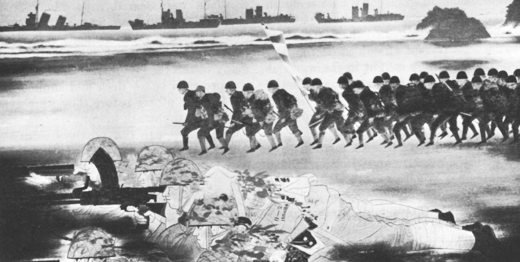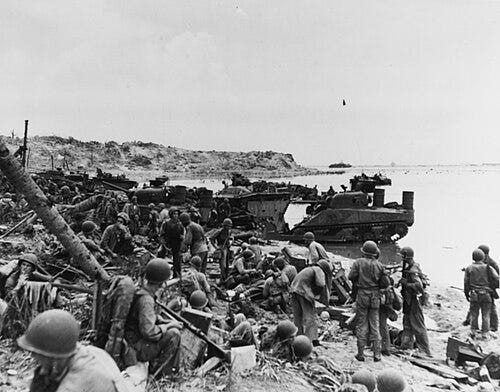10 August 1944 – The Battle of Guam Ends
How one island became a turning point in the Pacific and a symbol of sacrifice and strategy
How one island became a turning point in the Pacific and a symbol of sacrifice and strategy.
When I first came across the name Guam, I was a child flipping through an old world atlas. A tiny dot in the Pacific, far from anywhere I had ever been or even thought about visiting. Years later, I would come to learn how this small island played a huge role during one of the most brutal chapters of the Second World War.
On 10 August 1944, after weeks of heavy fighting, American forces declared Guam secure. The island, once lost, had been retaken. But the cost was enormous. This was not just a military victory. It was personal. It was political. And it changed the course of the Pacific War.
Guam before the war
Guam is the largest island in Micronesia and has long held strategic importance in the Pacific Ocean. It became an American territory after the Spanish-American War in 1898, and by the 1930s, it was seen as a vital outpost for American interests in Asia.
For the local Chamorro people, Guam was home. They lived under American administration, and many of them saw the United States as a protective force. But in December 1941, just hours after the attack on Pearl Harbor, Japanese forces invaded and quickly captured Guam.
It was the beginning of nearly three years of occupation.
Life under Japanese rule
The Japanese military administration ruled Guam with a harsh hand. Chamorros were subjected to forced labour, food shortages, and cultural suppression. Those suspected of supporting the Americans were imprisoned or executed. Children were made to learn Japanese. Churches were closed. The island was transformed into a garrison.
By 1944, the island had become a fortress. Thousands of Japanese troops were stationed there, and a network of tunnels, bunkers, and artillery positions had been dug into the hills and jungles.
The Americans knew retaking Guam would not be easy. But it was vital.
Why Guam mattered
Guam was not chosen simply because it had been taken. It was chosen because of where it was. Located roughly halfway between Hawaii and the Philippines, it provided a perfect base for launching further attacks on Japanese positions across the Pacific.
Guam had a large harbour, room for airfields, and space to build military infrastructure. It was the perfect stepping stone.
And for many in the American military, it was also personal. The island had been theirs. They had lost it. Now, they would take it back.
The invasion begins
On 21 July 1944, Operation Forager began. American forces, including Marines and Army divisions, landed on the western beaches of Guam. What followed was nearly three weeks of intense, unforgiving combat.
The terrain was brutal. Dense jungle. Steep cliffs. Scorching heat. Japanese soldiers were dug in deep, using caves and tunnels to mount ambushes and hold their ground.
The fighting was close and often hand-to-hand. Every inch of ground was contested. Tanks struggled in the mud. Artillery thundered day and night. The American advance was slow, methodical, and costly.
But by 10 August, the island was declared secure.
The human cost
Victory on Guam did not come cheaply. More than 7,000 American troops were killed or wounded. Japanese casualties were staggering. Of the nearly 20,000 Japanese soldiers on the island, only a few hundred were taken prisoner. Most were killed in combat or committed suicide rather than surrender.
Hundreds of Chamorros also lost their lives, caught in the crossfire or punished by retreating Japanese forces. Villages were destroyed. Families torn apart. The scars of the battle would remain for generations.
And yet, when I read about the survivors and their stories, what strikes me most is their resilience. The Chamorro people did not just endure occupation and war. They rebuilt. They remembered. And they honoured those who fought for their liberation.
A turning point in the Pacific
The recapture of Guam marked a shift in the Pacific War. With the island secured, the United States now had a forward base from which to launch attacks on the Philippines, Iwo Jima, and eventually Okinawa.
It also allowed for the construction of massive airfields. These would soon become launching pads for the B-29 bombers that would rain destruction on Japanese cities in the months ahead. Guam was not just symbolic. It was strategic. It gave the Allies reach and power in a region that had once been beyond their grasp.
As someone born in 1981, long after the war ended, I find it hard to imagine what it must have felt like to fight in such a place. The heat. The fear. The noise. And the sense that every decision carried the weight of life or death.
Reading the accounts from Guam, it becomes clear. This was not just another battle. It was a crucible.
Legacy and memory
Today, Guam is still a US territory. It hosts several major American military bases and is home to thousands of service personnel and their families. It remains a strategic location in a region that continues to be geopolitically important.
But Guam is more than its military. It is a living island with its own culture, language, and identity. The Chamorro people continue to preserve their heritage while navigating life within a modern world.
Every year, the island commemorates Liberation Day on 21 July, the day American troops landed. It is a time to honour both the suffering and the courage that marked the battle.
And on 10 August, for those who know the history, it is a day of quiet remembrance. A day when the guns finally stopped. When the island, so long occupied and scarred, could begin to heal.
Final thoughts
The Battle of Guam may not be as well-known as D-Day or Iwo Jima, but its impact was just as profound. It was a hard-won victory, achieved in terrible conditions, by soldiers and civilians who gave everything they had.
On 10 August 1944, the fighting ended. But the memory remains.
As a historian, and as someone looking back from the safety of another time, I feel a deep sense of respect for what was endured and achieved on that island. It reminds me that history is not just dates and maps. It is people. It is struggle. And it is moments like this, far from home, that shape the world we live in today.



